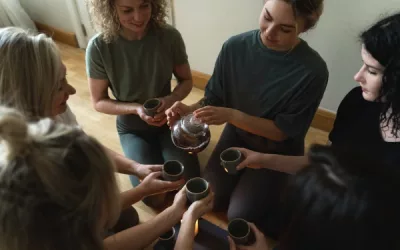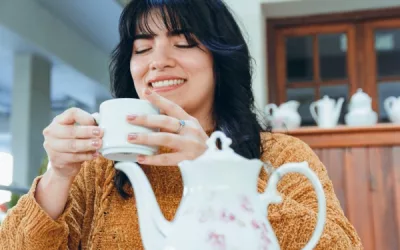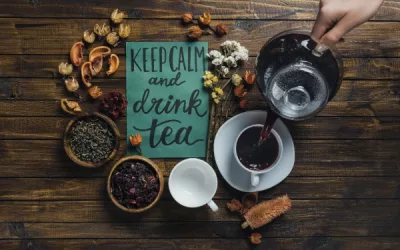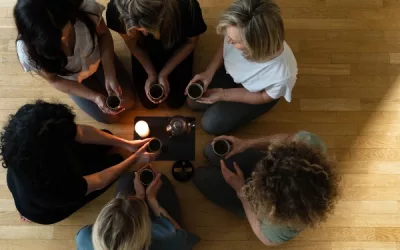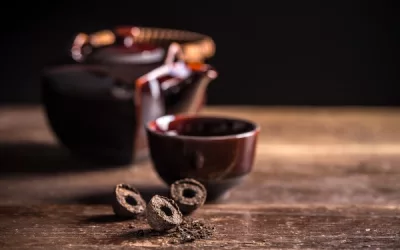Have you ever wondered how a simple cup of tea can evoke such rich traditions and social connections? Tea parties have been a cherished part of culture since the 17th century, from aristocratic gatherings in the UK to modern celebrations across the globe. Understanding their historical significance and contemporary relevance can transform your next gathering into a truly memorable experience. This article presents a comprehensive guide to hosting a delightful tea party, exploring themes, etiquette, recipes, and even the Tea Party movement’s impact on American politics. Let’s brew some inspiration together!
A tea party is a social gathering typically held in the afternoon where tea is served alongside light refreshments such as finger sandwiches, scones, pastries, and other small snacks. Tea parties can vary in formality and size, ranging from casual get-togethers with friends to more formal events with specific etiquette and dress codes. Here are some key elements of a traditional tea party:
- Tea: Various types of tea are served, including black, green, herbal, and specialty teas. Guests often have a choice and may add milk, sugar, or lemon to their tea.
- Refreshments: The food served at a tea party usually includes a selection of light bites. Common items are:
- Finger sandwiches (e.g., cucumber, egg salad, smoked salmon)
- Scones with clotted cream and jam
- Pastries, cakes, and biscuits
- Setting: Tea parties are often held in the afternoon, traditionally between 3 PM and 5 PM. The setting can be a home, garden, or tea room, often with an elegant and relaxed atmosphere.
- Etiquette: Depending on the formality of the event, there may be specific etiquette rules, such as proper ways to hold a teacup, how to stir tea, and how to serve and eat the refreshments.
- Decor: The table is usually set with fine china, teapots, cups, saucers, and sometimes floral arrangements. The decor can range from simple and cozy to elaborate and ornate, depending on the occasion.
- Purpose: Tea parties can be held for various reasons, such as socializing with friends, celebrating a special occasion (e.g., bridal shower, birthday), or simply enjoying a leisurely afternoon.
Tea parties have a long history, particularly in British culture, but they are enjoyed worldwide and can be adapted to suit different tastes and traditions.
Table of Content
- What is the historical significance of tea parties?
- How can You host a traditional English tea party?
- What are some popular tea party themes?
- What are the key etiquette rules for tea parties?
- What are some traditional tea party recipes?
- How do I incorporate modern twists into a tea party?
- What are some examples of fusion cuisine for tea parties?
- How can I plan a tea party for special occasions?
- What is the significance of the Tea Party movement in American politics?
- Conclusion
What is the historical significance of tea parties?
Tea parties have a rich and varied history that dates back to the 17th century. The practice began in aristocratic circles in the UK before evolving and spreading worldwide. Understanding the origins and cultural significance of tea parties can offer insights into their multifaceted role in social gatherings and traditions across the globe.
Tea parties originally served as a social and cultural activity among the British aristocracy. In the early days, tea drinking was an exclusive pastime for the elite, occurring in grand settings with fine china and elaborate decorations. Later, tea parties became popular across different social classes and geographical locations, adapting to the unique cultural backgrounds of each region.
What were the original purposes of tea parties?
Tea parties initially functioned as an elegant social event, reflecting sophistication and status. Aristocrats hosted them to display wealth and taste, and they offered:
- Networking opportunities among the elite
- Platforms for intellectual and political discussions
- Settings to showcase art, music, and fashion
- Moments of leisure and relaxation in beautifully decorated rooms
- Opportunities to form and strengthen societal connections
These gatherings allowed hosts and guests to engage in meaningful conversations while enjoying an array of delicacies. The tradition further extended to afternoon teas, where guests partook in a meal light enough to bridge the gap between lunch and dinner.
How did tea parties evolve over time?
Over time, tea parties transitioned from an elite event to a more inclusive social activity that transcended class boundaries. Key transformations included:
- Introduction of afternoon tea by Anna, the Duchess of Bedford, in the 1840s
- Tea rooms and tea gardens becoming popular among the working class
- Spread of tea culture to America, leading to events like tea dances
- Emergence of themed tea parties such as Victorian, garden, and bridal tea parties
- Integration of diverse cultural elements, ranging from Japanese tea ceremonies to Moroccan mint tea gatherings
Today, modern tea parties often include innovative themes and interactive activities, blending traditional tea etiquette with contemporary trends.
What cultural differences exist in tea party traditions?
Though the essence of tea parties remains constant, various cultural interpretations add a unique flair. Across the globe, tea traditions differ significantly:
- In British tea parties, emphasis is placed on etiquette, tiered trays of scones, sandwiches, and pastries, and a selection of teas paired with milk or lemon.
- In Japan, tea ceremonies (chanoyu or sado) are highly ritualistic, involving the preparation and presentation of matcha. These ceremonies reflect Zen Buddhist principles of harmony, respect, purity, and tranquillity.
- Moroccan tea rituals focus on brewing sweet mint tea and serve it in ornate metal teapots, poured dramatically from a height to create bubbles.
- Chinese tea culture may involve gatherings to enjoy varieties like Oolong and Pu-erh, often accompanied by performing specific tea brewing techniques known as Gongfu Cha.
- In Russia, tea parties often feature a samovar, a traditional tea urn, and robust black tea served with sugar, lemon, and jams.
These differences highlight the diverse ways people around the world enjoy tea and use it to foster social bonds.
Centuries ago, the importance of tea became evident in an iconic historical event – the Boston Tea Party of 1773. Disguised as Native Americans, American colonists dumped 342 chests of British tea into the Boston Harbour to protest against the Tea Act. This act challenged British authority and signified a pivotal moment leading up to the American Revolution. The event highlighted tea’s deep socio-political symbolism and its influence on history.
How can You host a traditional English tea party?
Hosting a traditional English tea party can be a delightful and charming experience. If you follow a few essential steps, you can create an afternoon to remember. To start off, you’ll want to focus on certain key elements: the tea itself, the food, and the decorations.
I’ve put together a handy table below to help you understand what you might need. This table includes different categories, examples, and quantity recommendations based on a party size of around 8 people.
| Item Category | Specific Examples | Quantity Recommendations |
|---|---|---|
| Tea Varieties | Earl Grey, English Breakfast, Green Tea | 3-4 varieties, 4-6 cups per person |
| Sweet Treats | Scones, Victoria sponge cake, Lemon drizzle cake | 2 scones per person, 1 large cake |
| Savoury Bites | Finger sandwiches – cucumber, smoked salmon, egg mayonnaise | 3-4 sandwiches per person |
| Tableware | Fine china teacups, saucers, teapots | 1 set per guest |
| Accessories | Tea strainers, sugar tongs, cake stands | 1 each, centrepieces |
| Decor Ideas | Lace tablecloths, fresh flowers, bunting | Enough to cover main table |
| Additional Items | Milk jugs, sugar bowls, lemon slices | Enough for each variety of tea |
Understanding and using this table can make preparation a breeze. You’ll want to start by choosing a variety of tea – try to include classics like Earl Grey and English Breakfast. Next, prepare both sweet treats and savoury bites to cater to diverse tastes. Don’t forget your tableware. Using delicate china can add an authentic touch, and finally, set the mood with appropriate décor.
What kind of tea should I serve?
When it comes to the tea selection, variety makes a big difference. Traditional choices are often the best way to go, as they are both time-tested and widely appreciated.
- Earl Grey: A black tea flavoured with oil of bergamot.
- English Breakfast: A bold and rich black tea blend.
- Green Tea: A lighter, subtly flavoured tea.
- Herbal Tea: For those who prefer caffeine-free options.
Offering 3-4 different options can cater to diverse preferences. Serve each type in separate teapots to preserve their unique flavours. Remember to have fresh lemon slices, milk, and sugar available so guests can customise their tea.
What food is appropriate for a tea party?
Finger foods are perfect for a tea party. The traditional English spread often includes a mix of sweet and savoury items.
- Scones: Serve with clotted cream and strawberry jam.
- Victoria Sponge Cake: A light and fluffy option.
- Finger Sandwiches: Classic options include cucumber, smoked salmon, and egg mayonnaise.
- Fruit Tartlets: Mini pastry delights filled with fresh fruit.
Provide enough so each guest can try everything. Balance is key. Mix rich and light items to keep the palate entertained. Display everything elegantly on a multi-tier cake stand for easy access.
In the late 1800s, afternoon tea became an established ritual in British society, thanks to Anna, the Duchess of Bedfordshire. It bridged the gap between lunch and dinner, and quickly became a social event featuring dreamy spreads of cakes, sandwiches, and, of course, varied teas.
Imagine hosting your tea party with the same flair and charm that made those gatherings a staple in Victorian times!

What are some popular tea party themes?
Tea parties are like a blank canvas – you can make them as fancy, fun, or funky as you like. Whether you fancy a trip down memory lane, a romp through a garden, or a bit of holiday cheer, there’s a tea party theme for you. Let’s spill the tea on some popular ones, shall we?
A vintage tea party brings back a golden era where elegance was everything. Think porcelain teacups, doilies, and grandma’s jam-filled scones. Garden tea parties are a chance to soak up some sunshine while you’re sipping your Earl Grey. Picture this: blooms everywhere, chirping birds, and the scent of fresh grass. No bugs allowed, of course.
If you’re the festive type, a holiday-themed tea party serves a bit of seasonal sparkle with your sips. Christmas, Halloween, or even Easter – pick your poison, and dress it up with holiday cheer. For the tiny tea drinkers, children’s tea parties are a whimsical wonderland. Imagine mini-mysteries, tiny treats, and maybe a stuffed animal or two.
Lastly, let’s not forget themed costume tea parties. Let your imagination run wild with everything from Alice in Wonderland to Victorian elegance. Costumes encouraged, monocles optional.
What elements define each tea party theme?
Here’s the lowdown on what each theme needs to pop:
- Vintage Tea Party: Vintage china, lace tablecloths, antique serving trays, and classical music.
- Garden Tea Party: Fresh flowers, potted plants, garden umbrellas, and birdcages.
- Holiday-Themed Tea Party: Seasonal decor, themed table settings, holiday music, and festive lights.
- Children’s Tea Party: Colourful cups, cartoonish napkins, small chairs, and playful activities.
- Themed Costume Tea Party: Appropriate costumes, complementary décor, themed invitations, and related party games.
The essence of each theme lies in these defining elements. It’s the small touches that can transform your ordinary gathering into an extraordinary event. Now, we move on to the tummy rumbling details.
A theme isn’t just a visual treat; it influences your taste buds too.
- Vintage Tea Party: Delicate finger sandwiches, classic scones with clotted cream, macaroons, and traditional teas like Darjeeling.
- Garden Tea Party: Fresh fruit salads, herb-infused teas, light pastries, and maybe a cheeky mimosa or two.
- Holiday-Themed Tea Party: Gingerbread cookies for Christmas, spooky finger foods for Halloween, chocolate eggs for Easter, and seasonally flavoured teas.
- Children’s Tea Party: Mini sandwiches, colourful cupcakes, themed cookies, and fun-shaped jelly treats.
- Themed Costume Tea Party: Customised snacks and drinks that fit the theme – think ‘Eat Me’ cookies for Alice in Wonderland.
By aligning your menu with your theme, you create a cohesive experience that pleases the eye and the stomach. Let’s jazz it up with suitable decorations next.
What decorations are suitable for different themes?
Decorations are like the fairy godmother of your tea party – they can change everything.
- Vintage Tea Party: Antique teapots, pastel bunting, lace napkins, and framed vintage photos.
- Garden Tea Party: Floral centrepieces, fairy lights, rustic seating, and garden lanterns.
- Holiday-Themed Tea Party: Themed table runners, holiday wreaths, seasonal garlands, and matching crockery.
- Children’s Tea Party: Cartoon character balloons, colourful tablecloths, themed party hats, and playful banners.
- Themed Costume Tea Party: Decor that matches the era or character – pirate-themed flags, medieval goblets, or futuristic LED decor.
These decorative touches will not only align with your chosen theme but also wow your guests before they even take a sip of their tea.
Back in the early 1900s, renowned socialite Lady Randolph Churchill (Winston Churchill’s mother) hosted the crème de la crème of tea parties in London. With her exquisite taste, she combined elements like high fashion, impeccable manners, and carefully curated guest lists to make her tea parties legendary. It was not just about the tea; she made these gatherings a symbol of social status and sophistication. Now that’s setting the bar high!
So, the next time you decide to host a tea party, remember: the devil is in the details, and the fun is in the themes!
What are the key etiquette rules for tea parties?
Tea parties, at first glance, might seem like a simple affair. Boil some water, toss in a few leaves, throw in some biscuits, and voila! But hold on! If you think that’s all there is to it, you’re in for a surprise. From seating arrangements to thank-you notes, there’s an elaborate etiquette spectrum that ensures your tea party is more posh than chaos. Let’s dive into this world of elegant sipping!
Proper etiquette can transform your tea party from a casual gathering to a refined social experience. We’ll break down the key areas: seating arrangements, serving order, conversation topics, dress codes, and thank-you notes.
What should guests remember when attending a tea party?
As a guest, you are one of the stars of the show, and you don’t want to flop your big performance. Follow these simple rules, and you’ll be the apple of everyone’s eye.
- Arrive on time: Fashionably late might work for some events but not here. You don’t want the host staring at the teapot waiting for you, right?
- Dress appropriately: Think more “Downton Abbey” and less “Sunday Netflix binge”.
- Brush up on your small talk: Topics like the weather, books, or travel are safe bets. Steer clear of politics or anything that could spark a heated debate.
- Mind your manners: Put that pinky finger down! Hold the teacup properly and sip, don’t slurp.
- Show gratitude: A simple “thank you” goes a long way. And yes, sending a thank-you note afterward is not old-fashioned; it’s classy.
If you follow these tips, you’ll not only impress your host but likely score another invite.
How should hosts prepare for their guests?
So, you’ve decided to host a tea party. Brave move. Now, you have to make sure it doesn’t turn into a circus. Here’s how you can nail it:
- Set the seating arrangement: Place cards can save you from awkward social dynamics. Keep those who talk too much and those who talk too little balanced.
- Plan your serving order: Traditionally, tea is served first, followed by savories, scones, and sweets in that order. Remember, the queen doesn’t eat her dessert first.
- Select appropriate conversation pieces: Have some neutral and engaging topics ready. Historical facts about tea or amusing anecdotes work wonders.
- Set a dress code: Specify attire on your invites so nobody shows up in their favourite superhero pyjamas.
- Prepare thank-you notes: Stock up on stationery so you can promptly send your guests a note of gratitude for attending.
Your guests will feel special, and they’ll remember your event as a well-organized, pleasant affair.
What are common faux pas to avoid?
Sometimes, it’s what you don’t do that makes all the difference. Avoid these social blunders, and you’ll keep everyone smiling.
- Don’t start eating before the host does: Wait for the signal. Jumping the gun can make you the tea party villain.
- Don’t dunk your biscuits: Seriously, this isn’t a shepherd’s pie!
- Don’t overfill your teacup: A half-full cup means easier sipping and no embarrassing spills.
- Avoid controversial topics: Don’t drag Brexit into this serene setting.
- Don’t forget your manners: Chew with your mouth closed, use your napkin, and say please and thank you.
These faux pas can ruin the vibe faster than you can spill a cup of Darjeeling. Stay clear, and you’re golden.
In the grand tapestry of history, tea parties have had their fair share of drama. Take, for instance, the Boston Tea Party of 1773. Fed up with the British tax on tea, American colonists decided to make a bold statement.
No, they didn’t send a “strongly worded” letter. Instead, they dumped 342 chests of tea into the Boston Harbour. Not the kind of tea party you’d want to emulate, but it did have a lasting impact and showed how tea could be both a symbol of friendship and rebellion.
So, while you probably won’t be staging protests, understanding the etiquette ensures your tea event is memorable for all the right reasons!
What are some traditional tea party recipes?
When it comes to hosting a tea party, it’s all about the snacks. Think dainty little bites that are both delicious and decorous. Traditional tea party recipes include classics like finger sandwiches, scones with clotted cream, assorted pastries, tea-infused desserts, and a variety of teas, including herbal selections to suit every palate. Let’s dive into the details of these delightful morsels.
First off, we have the finger sandwiches. They might be small, but they’ve got big responsibilities. Next up, scones, the crowning glory of any tea party. Then there are pastries—tiny works of art that taste as good as they look. Don’t forget the tea-infused desserts, as they bring a thematic twist to the table. To wash it all down, an array of herbal teas offers something for everyone. Let’s not beat around the bush any longer. Here’s how you can recreate these at home.
What are the most popular sandwich fillings?
It’s all about the filling when it comes to finger sandwiches. These tiny delights pack a flavour punch that leaves a lasting impression.
- Cucumber and Cream Cheese: A classic as essential as the little black dress in a wardrobe. Thinly sliced cucumber layered over a spread of cream cheese, seasoned with a pinch of salt and pepper, brings sophistication to the table.
- Egg and Cress: Hard-boiled eggs mashed with a touch of mayo, a hint of mustard, and a sprinkle of garden-fresh cress. It’s a flavour grenade that explodes in your mouth.
- Salmon and Dill: Smoked salmon combined with a light cream cheese spread and a whisper of dill. It’s posh, it’s timeless, and it’s oh-so-good.
- Ham and Mustard: Thinly sliced ham with a tangy mustard spread that will make you wonder why you ever bothered with plain ham sandwiches.
- Chicken and Tarragon: Shredded chicken breast, mayonnaise, and fragrant tarragon—a combo that screams sophistication.
These fillings offer a variety of flavours and textures, ensuring that your guests can find something they love and may have many Oohs and Aahs coming your way.
How can I make scones from scratch?
Scones: the bread and butter (quite literally) of a traditional tea. Making them from scratch is easier than you think and oh-so-rewarding.
- Ingredients:
- 225g self-raising flour
- 55g butter
- 25g caster sugar
- 150ml milk
- A pinch of salt
- Method:
- Preheat your oven to 220°C. Grease a baking tray.
- Sift the flour and salt into a bowl. Add the butter and rub it in until the mixture resembles fine breadcrumbs. Stir in the sugar.
- Make a well in the middle and add the milk, a bit at a time, mixing until you have a soft dough.
- Turn the dough onto a floured surface and knead very lightly. Pat out to a round about 2cm thick and use a 5cm cutter to stamp out rounds.
- Place on the baking tray and brush the tops with milk. Bake for 12-15 minutes until well risen and golden.
- Serving: Once cooled, split them and slather with clotted cream and a good dollop of jam. Serve with a smile and perhaps a satisfied smirk.
Making scones from scratch can be genuinely satisfying, and their warm, buttery smell will fill your home with a welcoming, cosy feeling.
What desserts pair well with tea?
For a tea party to be memorable, you need desserts that complement the brews on offer. Tea and desserts are a match made in flavour heaven.
- Eclairs: These French classics, filled with cream and topped with chocolate, offer a light sweetness that pairs well with both black and green teas.
- Madeleines: These petite sponge cakes are perfect for dunking, and their delicate lemony flavour brings out the floral notes in many teas.
- Biscuits (Cookies for our friends across the pond): From shortbread to ginger snaps, a crisp biscuit can be dipped into a warm cup, making it the ultimate comfort food.
- Tea-infused cakes: Earl Grey cupcakes or matcha-flavoured cookies add an extra layer of depth to your tea party offerings.
- Fruit Tarts: A mix of seasonal fruits over a creamy custard base in shortcrust pastry. It’s a refreshing bite that pairs beautifully with herbal and green teas.
Small servings mean your guests can sample a bit of everything without feeling guilty—unless, of course, they devour everything in sight.
In 1773, a different kind of tea party took place—a bit less refined and a tad more rebellious than your average garden gathering. The Boston Tea Party saw American colonists, frustrated with British taxation without representation, dump an entire shipment of tea into Boston Harbour.
This cheeky move was a statement of defiance against the British government and arguably one of the sparks that ignited the American Revolution. Over 300 chests of tea were destroyed, but it was less about the tea and more about sending a powerful message of independence and self-determination.
Now, back to your tea party; thankfully, the stakes aren’t quite as high. So, brew that pot of tea, arrange those dainty morsels, and let the good times steep.
How do I incorporate modern twists into a tea party?
Tea parties might sound like something your grandma and her mates do, but they don’t have to be stuck in the past. Let’s bring some 21st-century flair to this classic tradition. Ready? Let’s dive into some innovative ideas to jazz up that next gathering you’ve got planned.
First up, we have fusion cuisine. Think of your classic tea sandwiches having a wild night out and mingling with global flavours. Then there are themed cocktails—because who says you can’t enjoy a tipple or two at a tea party? Interactive food stations take centre stage, letting guests get hands-on with their food. And don’t even get me started on digital invitations and social media sharing—because why not make your tea party go viral?
What are some examples of fusion cuisine for tea parties?
Fusion cuisine is where the magic happens. Imagine combining the elegance of a tea party with the excitement of international flavours. Here’s a taste of what that could look like:
- Sushi sandwiches: Swap the cucumber for sushi-grade salmon, creamy avocado, and a dollop of wasabi mayo wrapped in nori.
- Dim sum delights: Steamed bao buns filled with crispy duck, hoisin sauce, and scallions.
- Tikka masala tea sandwiches: Traditional British tea sandwiches get an Indian twist with spiced chicken tikka and cool cucumber yoghurt.
- Mediterranean bites: Focaccia bread with a mixture of hummus, roasted red peppers, and kalamata olives.
- Tex-Mex teacakes: Mini cornbread muffins with pulled pork and a zingy salsa topping.
By blending traditional and international flavours, you keep things fresh and exciting. Your guests won’t know what’s hit them!
How can cocktails complement tea?
Now, let’s talk cocktails. Yes, mojitos and martinis are invited to your tea party too! But how do they mesh with your beloved Earl Grey?
- Tea-infused spirits: Gin or vodka infused with black tea adds depth to your drinks.
- Earl Grey martini: A suave blend of Earl Grey tea, gin, simple syrup, and a twist of lemon.
- Matcha margaritas: A zesty mix of matcha green tea, tequila, lime juice, and agave syrup.
- Peppermint mojito: Peppermint tea fused with rum, fresh mint, lime, and soda.
- Chai bourbon: Bourbon mixed with chai tea and a hint of vanilla for a smooth finish.
These tea-infused cocktails don’t just add flair—they enhance the entire experience, making each sip a journey.
If you’re still using paper invites, you’re missing out on a world of convenience and style. Social media invites are where it’s at:
- Instant reach: Spread the word faster than you can say “brew another pot.”
- Creative touch: Customise invitations with videos, gifs, or animations for extra pizzazz.
- Eco-friendly: Save trees and your conscience by going digital.
- RSVP management: Easily track who’s in and who’s out without the need for follow-ups.
- Engagement: Create a buzz with event hashtags, countdowns, and teasers to build excitement.
Being able to personalise and track responses effortlessly ensures you have the event of the season.
Let’s circle back in time to the 1960s, when the American socialite C.Z. Guest hosted her legendary tea parties. These gatherings included everyone from writers like Truman Capote to political figures and Hollywood stars. Instead of sticking to the standard cucumber sandwiches, she was all about jazzing things up.
Her parties were known for having exotic jams and unique finger food, all served against the backdrop of her lavish estate. Guest essentially started doing what we’re talking about now—giving a classic tradition a fresh, new twist. So, view this revamp not as breaking tradition but as continuing a history of innovation!
How can I plan a tea party for special occasions?
Planning a tea party for special occasions is a clever way to blend elegance with a hint of quirkiness. Weddings, baby showers, birthdays, corporate events, and festive holidays are all prime candidates for tea parties. Whether you’re crafting an intimate gathering or a grand celebration, here’s everything you need to knock it out of the park.
First, let’s dive into what makes weddings, baby showers, birthdays, corporate events, and festive holidays unique and how you can tailor your tea party to fit each special occasion.
What unique elements should be included for weddings?
A wedding tea party should be nothing short of magical. You’re essentially blending Victorian grace with today’s flair. So, let’s get into the key elements:
- Vintage crockery and fine china: The more your teacups and saucers look like they’ve time-travelled from your great-grandma’s cabinet, the better.
- Floral centerpieces: Opt for peonies, roses, and hydrangeas. You want flowers that scream romance.
- Personalised tea blends: Imagine a “Bride and Groom Special Blend” with their favourite flavours.
- Elegant finger foods: Think cucumber sandwiches, scones with clotted cream, and mini quiches.
- Venue selection: Gardens, historic mansions, or any place with a serene backdrop works perfectly.
This isn’t just a party—it’s an experience. The couple’s commitment is reflected in every tiny detail, creating memories long after the last sip of tea.
How can I tailor a tea party for a baby shower?
Baby showers are all about celebrating the impending arrival of a little bundle of joy. A tea party for this occasion should be light, cheerful, and full of charm.
- Soft pastel colours: Think baby blues, pinks, and yellows. Keep it light and dreamy.
- Games and activities: Baby name bingo, guess the baby food flavour, and predicting the baby’s arrival date.
- Themed treats: Baby bottle-shaped cookies, and cupcakes with little storks or baby blocks.
- Non-caffeinated tea options: Think herbal teas like chamomile or peppermint, mums-to-be should avoid too much caffeine.
- Cosy setting: Living rooms, cozy patios, or quaint tea rooms make perfect venues.
This sets a welcoming and loving atmosphere, fitting for a soon-to-be mum where the focus is on joy, laughter, and baby-talk galore.
What themes work best for festive holidays?
Festive holidays demand a tea party that’ll make everyone feel as merry as they do stuffed with seasonal goodies. Some tried-and-true themes include:
- Christmas: Think of a Winter Wonderland with cranberry scones and peppermint tea, plus a big ol’ Christmas tree in the corner.
- Easter: Perfect excuse for a garden tea party with Easter egg hunts and bunny-shaped cakes.
- Halloween: Black tea with a hint of spooky spices, served in hauntingly cute teacups.
- Valentine’s Day: Roses, heart-shaped cookies, and a selection of love-inducing teas like rosehip or strawberry.
- Cosy corners: Ideal to create a sense of warmth during colder holidays.
This ensures your guests are immersed in the holiday spirit, enjoying the blend of good company and delicious brews.
Speaking of festive tea parties, let me tell you about this magnificent event. In 1953, the Queen’s Coronation Festivities included tea parties throughout the UK. Locals gathered in the streets, homes, and community halls, celebrating with tea and laughter.
It was an emblem of unity and national pride, making it a historical milestone and a testament to the power of tea in bringing people together. Even today, the echo of that nationwide celebration resonates whenever we brew a pot and share it with friends and family.
What is the significance of the Tea Party movement in American politics?
When it comes to the Tea Party movement in American politics, we’re talking about a political uproar that didn’t just shake things up—it rattled the whole darn tree. Originating in the late 2000s, this movement aggressively pushed a conservative agenda and became a powerful force within the Republican Party. Its impact was felt across various aspects of American politics, from key figures to major events and political ideologies. Let’s break it down and dive into the nitty-gritty.
What sparked the formation of the Tea Party movement?
Picture this: it’s 2008, and the Global Financial Crisis has hit like a ton of bricks. People are losing jobs faster than you can say ‘recession,’ and Uncle Sam’s got his pockets turned inside out. Now cue in the government bailouts like the Troubled Asset Relief Program (TARP) and the American Recovery and Reinvestment Act—and boom! Folks who thought Uncle Sam was sticking his nose where it didn’t belong weren’t too thrilled.
- Economic Grievances: Massive bailouts and stimulus packages left many feeling the government was way too involved in the economy.
- Rick Santelli’s Rant: CNBC reporter Rick Santelli’s famous rant from the floor of the Chicago Mercantile Exchange in February 2009 got the ball rolling. He called for a ‘Chicago Tea Party,’ sparking a national outcry.
- Fiscal Conservatism: A longing for smaller government and reduced public spending fanned the flames.
- Grassroots Activism: Mobilisation through town hall meetings, social media, and, yes, actual tea parties floated the movement into mainstream politics.
It’s like a perfect storm of economic discontent, political rhetoric, and grassroots activism lit the fuse.
How has the movement influenced modern politics?
The Tea Party movement didn’t just knock on the door—it kicked it wide open. Picture it as a feisty little terrier shaking up the big dog that is American politics.
- Shift in the Republican Party: The GOP tilted further to the right. Fiscal responsibility and limited government became battle cries.
- Election Outcomes: 2010 saw a wave of Tea Party-backed candidates sweeping into Congress. Remember the ‘Red Wave’? That was them.
- Policy Influence: They pressed for spending cuts and challenged the status quo on many fronts, like the Affordable Care Act (Obamacare).
- Polarisation: Politics became more divided. The left went left, and the right went even righter.
Like it or not, these guys injected a dose of red-hot energy into the political scene.
What are the criticisms of the Tea Party movement?
No movement without its detractors, right? The Tea Party was no exception.
- Extremism: Critics often pointed to the movement’s aggressive tactics and rhetoric, accusing it of breeding divisiveness.
- Lack of Coherence: While they were all about small government, specific policies and approaches varied wildly.
- Obstructionist Tendencies: They earned a rep for blocking legislation, even if it meant halting government operations—like the 2013 government shutdown.
- Questionable Alliances: Allegations of ties with big money and special interests, contradicting their grassroots image, were frequent topics of critique.
It’s like they couldn’t please everyone, but then, who can?
Speaking of rumbles in politics, here’s a bit of trivia from across the pond. Ever heard of the Boston Tea Party? Back in 1773, American colonists, irked by ‘taxation without representation,’ tossed 342 chests of British tea into Boston Harbour. Talk about making a statement! This act of rebellion brewed up tensions that eventually boiled over into the Revolutionary War. These days, it’s remembered more for the symbolic ‘tea’ than any actual political platform. So, whether it’s a bunch of 18th-century rebels chucking tea or modern conservatives shaking up Congress, tea and politics go way back.
Conclusion
In reflecting on the enchanting world of tea parties, it’s clear that these gatherings are steeped in rich history and hold significant cultural value. From their aristocratic origins in the UK to the modern adaptations we see today across various cultures, tea parties have evolved into a symbol of social interaction, adaptation, and celebration. The traditional English tea party offers not only a delightful experience but also a canvas for creativity through themed variations and etiquette etiquette that enhance the occasions.
Understanding the necessary elements for hosting a successful tea party—from selecting the perfect tea varieties and delectable food options to choosing the right theme and décor—allows us to embrace this time-honoured tradition in our own unique ways. Furthermore, as we explored the etiquette of tea parties, it became evident that attention to detail speaks volumes about respect and hospitality towards our guests.
As we head into our next hosting adventure, I encourage you to contemplate how these rituals can be modernised and personalised, highlighting your individuality while still honouring tradition. The incorporation of fusion cuisine, themed cocktails, and digital innovations keeps the spirit of the tea party alive and relevant, allowing it to transcend generations.
Moreover, the diverse applications of tea parties in special events remind us that they are more than mere social gatherings—they are opportunities to connect, celebrate, and create lasting memories. This superb blend of history, creativity, and etiquette culminates in something truly special. In the words of T.S. Eliot, “Their words had a music of their own,” and it is through such gatherings that we can feel the rhythm of shared experiences. So, what will your next tea party reveal about you?
Resources
- Coffee, Tea, and Chocolate in Early Colonial America
- Interaction Rituals and Religious Culture in the Tea Party
- The Dangers of Tea Drinking
- Afternoon tea: How to do the convivial tradition right?
- Chai as a Colonial Creation: The British Empire’s Cultivation of Tea as …
- Tea Politics | Tea: Consumption, Politics, and Revolution, 1773-1776 …


